Arkeofili [external link], a Turkish online magazine and portal dedicated to archaeological news and reports on archaeological sites and discoveries in Turkey and the world approached DAI’s Göbekli Tepe research staff with a couple of questions regarding excavations at site and the current state of research. Since the recently published interview [external link] received broad interests and we were repeatedly asked if an English translation was available, we are pleased to provide it here with courtesy of the Arkeofili staff for those not fluent in Turkish.
What you always wanted to know about Göbekli Tepe.
(Interview by Arkeofili staff with Jens Notroff, DAI.)
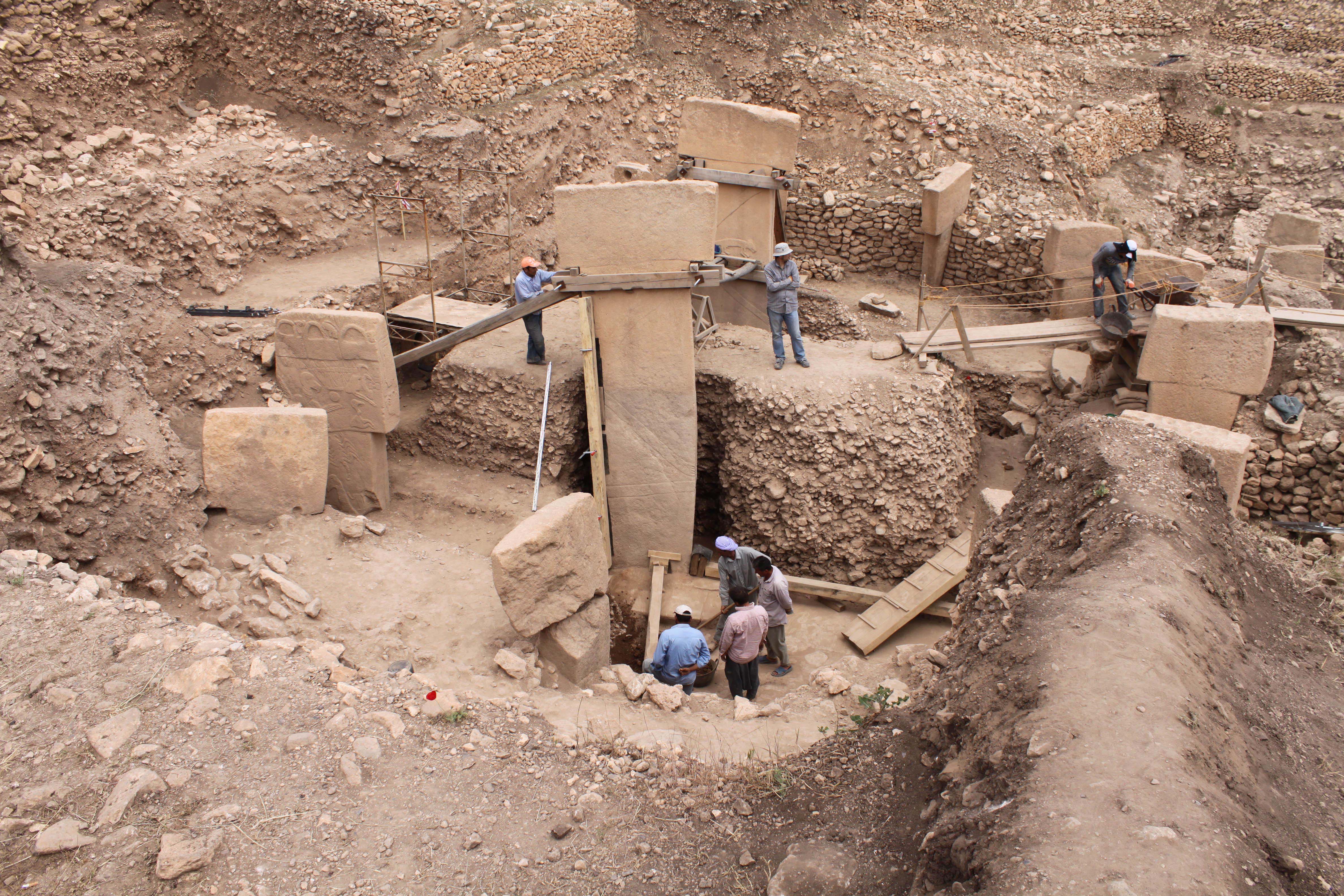
(Photo: DAI, O. Dietrich)
What is Göbekli Tepe and what is it not? Is it a temple, a house, or both (since E. B. Banning put forward that it could be domestic houses)?
That’s actually the crucial question: What was it? And that’s the challenge as well – since we do not have any written sources from that time explaining anything about world view and everyday life of the Neolithic hunter-gatherers who created this and related sites, we have to form our interpretations exclusively on the material culture they left to us.
After about 20 years of excavation and research we start to perceive the site of Göbekli Tepe as a kind of meeting point. A gathering centre of several groups of hunters roaming the area (based on iconographic parallels in the decoration of stone vessels, plaquettes etc. we may assume a catchment area of up to 200 km). Apparently, Göbekli Tepe was an important point in the landscape for regular encounters and exchange.
It is somehow true that archaeologists often all too easily use the term ‘ritual’ to describe finds and features we do not understand. And it is also true that the distinction of sacred versus profane as two strictly separated spheres is a rather modern, western view. However, we did not come up with our interpretation out of the blue – there are a couple of peculiar features about Göbekli Tepe supporting these ideas.
- Pillar 1 in Enclosure A shows a net-like pattern formed of snakes and a ram (Photo: C. Gerber, coopyright DAI).
- Pillar 2 in Enclosure A with a vertical sequence of three motifs: bull, fox and crane (Photo: C. Gerber, copyright DAI).
Since we do know the typical settlement architecture of this area and period from other contemporary sites like Nevalı Çori and in particular Çayönü in the Turkish Tigris area or Mureybet and Jerf el Ahmar in the Syrian Euphrates region, we can note that the structures at Göbekli Tepe do differ from these. The monumental circular enclosures of the older PPN A layer of Göbekli Tepe with their characteristic large T-shaped monoliths form a different, a very distinct kind of building. A type which indeed can be found in a lot of the known settlements as well – structures we usually call ‘community’ buildings. Yet while there mostly in settlements only one example of these special purpose buildings can be found, at Göbekli Tepe there seems to be a noticeable cumulation of these. Whether we really would need to call them ‘temples’ basically depends on a definition of that term we agree on. Yet usually the historic characterisation of temples would ask for some deity (or deities) being housed there – a complex concept of religion we could not provide for the early Neolithic as of yet. However, with hands and arms and elements of clothing depicted in relief, the characteristic T-pillars of Göbekli Tepe clearly own an anthropomorphoic identity and thus could be understood as monumental sculptures. Highly abstracted, faceless, larger-than-life depictions which clearly are taking up a different sphere than the naturalistic life-sized sculptures also known from the period.
What has Göbekli Tepe changed about our knowledge of history? Why is the discovery of and the information gained from Göbekli Tepe so important?
The most important discovery about Göbekli Tepe may have been the insight into what seems to be a very complex degree of organization within and among these early Neolithic hunter-gatherer groups. To construct monumental architecture like the Göbekli Tepe pillars and enclosures indeed must have asked for a certain degree of labour division as well as cooperation between different groups, organization and coordination of this work. The realisation that these still highly mobile people invested time and effort into rather large-scale communal projects and thus may have triggered a whole slew of development subsequently leading into the so-called Neolithic lifestyle with larger settled communities, agriculture, and husbandry, is an important contribution to our understanding of the Anatolian Neolithic. Food would need to have been made available for workers gathered there, and demands may soon have exceeded returns of prevailing hunting and foraging strategies – and thus may well have been led to the exploration and exploitation of new food sources. To some degree this somehow turned around cause and effect of our earlier picture of these line of events.
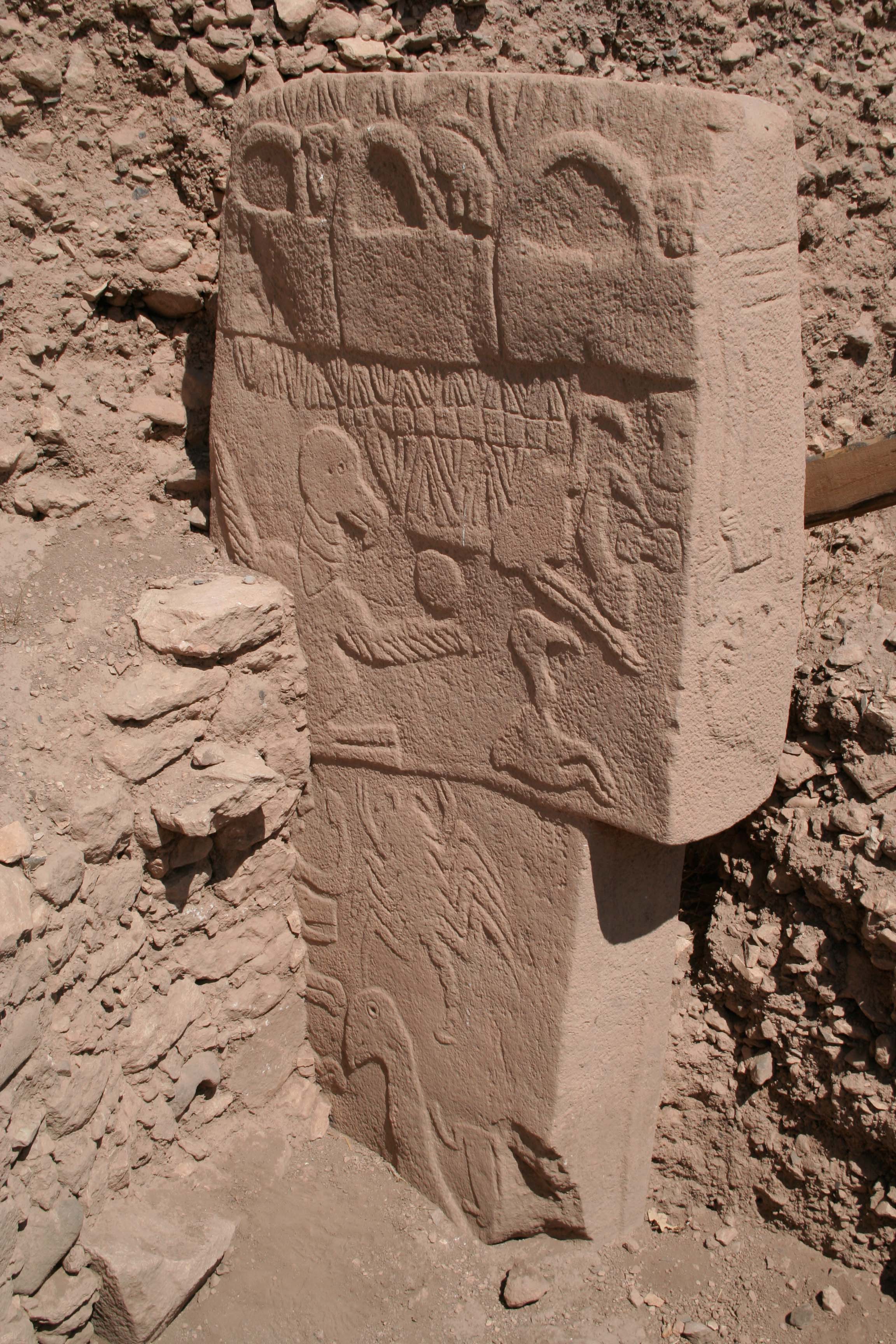
(Photo: DAI, O. Dietrich)
Why would/could the people of that time need a monumental building such as Göbekli Tepe?
Ethnographic studies have shown that communal projects and feasts are an important factor to strengthen group cohesion. Particularly rather small gunter-gatherer bands are essentially reliant on regular meetings to exchange information, goods, and marriage partner for instance to keep the gene pool fresh. It surely is no coincidence that the site of Göbekli Tepe was created where it is – on the highest point of the mountain ridge, a landmark widely visible. Against this background it seems suitable to interpret the architecture there as mark of these gatherings. The pillars with their rich depictions representing groups and somehow storing their memory. Large amounts of animal bones, hunted game strictly, speak in favour of huge feasts hold here and residue in stone vessels with a capacity of up to 160 litres may even hint at the consumption of alcoholic beverages. So-called workforce feasts like these (this is another insight from social anthropology) are a great means to attract the mapower necessary to carry out large communal projects like the constructions at Göbekli Tepe undoubtly must have been. Regular reparation and re-arrangement within the enclosures furthermore gives the impression of on-going continued construction activity, making it even more probable that this was an important factor of the site at all: a reason to bring people together.

(Photo: DAI, E. Kücük)
Do we know what the approximate manpower is needed to build Göbekli Tepe? Were there any experimental projects/research about how the structures were built? Or is anything of that sort planned for the future? Do we have any information on the building techniques?
The surrounding rock plateaus of Göbekli Tepe clearly give us an idea on how these prehistoric stone masons were working. Next to a number of ‘negative’ hollows, where workstone pieces were extracted, a huge amount of flint and bedrock stone tools as well as some unfinished pieces like broken T-pillars and other work pieces clearly illustrate how and where the Prehistoric masons were working.
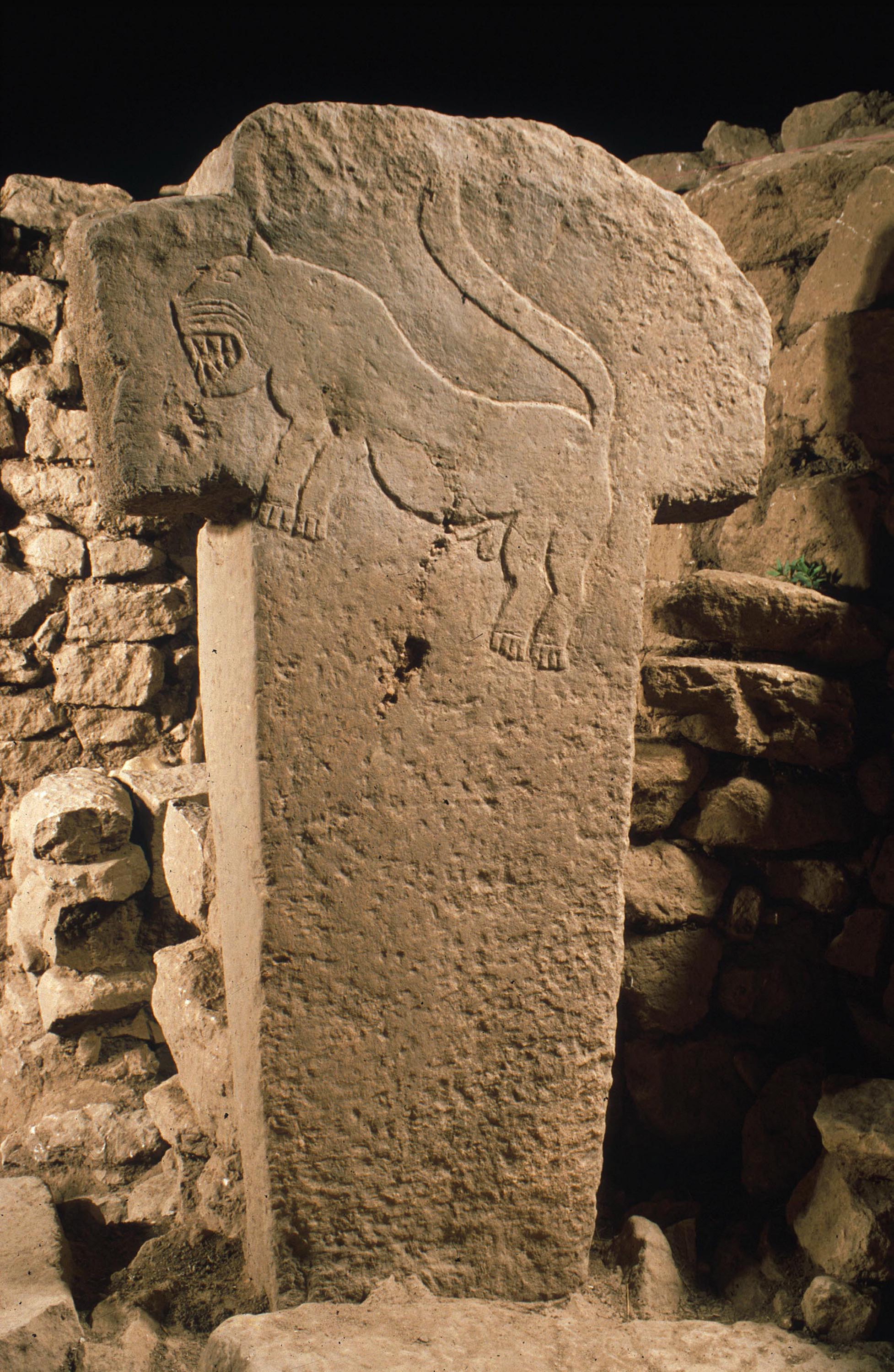
(Photo: DAI, D. Johannes)
Calculating exact numbers for the necessary workforce, however, would be a bit more challenging since too many factors need to be considered. Figures for the erection of the giant moai statues of Rapa Nui (Easter Island) for instance are ranging from 20 up to 75 people which would be required to move one of the statues over a distance of 15 km. Yet ethnographic records from the Indonesian Island of Nias mention up to 525 men involved in hauling a megalith of 4 m3 over a distance of 3 km to its final location. Another example from Indonesia points out that such a large number of participants is not necessarily caused exclusively by the labor involved, but that other factors have to be kept in mind as well. In Kodi, West Sumba, the transport of the stones used for the construction of megalithic tombs itself is ritualized and requires a large number of people to be involved as witnesses. Thus, also social aspects like the acquisition and maintaining of prestige among the individuals participating needs to be incorporated into the models of the erection of monumental structures.
Experiments were carried out recently by colleagues to get an idea how much work and effort would have been involved into the several processes of breaking and working the stones pieces, but are still awaiting final evaluation and publication. It should be noted that these results, while delivering useful insights, could be approximate values at best since they hardly could exactly match the skills of Prehistoric specialized craftsmen.
What does Göbekli Tepe tell us about the hierarchical organisation of people at that time?
Like already discussed above, the probably large amount of workforce necessary to create the enclosures of Göbekli Tepe speaks in favour of an emerging complex social structure. We were used to assume these hunter-gatherer bands are organised strictly egalitarian, yet a communal project like this involving different groups and complex constructions must have asked for at least some degree of coordination and labour specialisation.
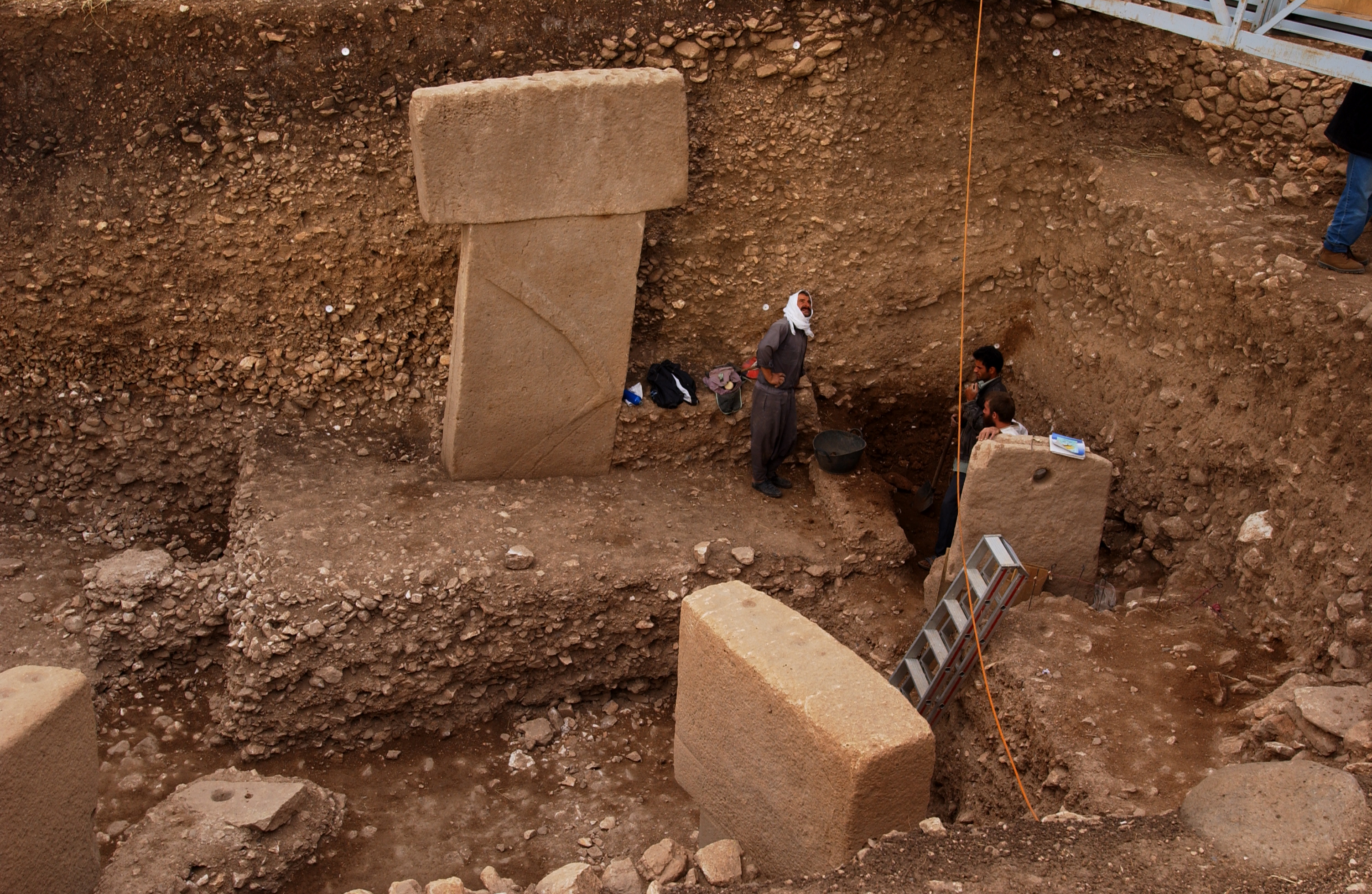
(Photo: DAI, K. Schmidt)
Is there any evidence for any production activities in Göbekli Tepe (for instance agriculture, or beer-brewing as was mentioned by Dietrich et al.)?
Traces of typical domestic activities are missing so far at Göbekli Tepe, as are any traces of Prehistoric agriculture or husbandry – any remains of plants and animals discovered as of yet hint at the respective wild forms only.
However, numerous flint tools and flint flakes clearly hint at flint knapping on a grand scale taking place at and around Göbekli Tepe. The possible production of beer in the frame of large scale feasting is indeed a point worthy of discussion in the frame of these already mentioned large feasts – since preliminary chemical analysis hints at oxalate residues in large stone vessels at the site.

(Photos: DAI, K. Schmidt & N. Becker)
What do you think of the depictions on the steles? What could they be telling us – could they be narrating something?
The wide range of varying motifs and recurrent symbols (and combinations thereof) suggests that these are not mere decorative elements; these depictions rather have an extraordinarily complex, mythological, content with indeed a likely narrative character. The symbols themselves are plain to see (naturalistic portrayals interchange with strongly abstract signs) and yet the meanings behind them, so obvious to the people in the Neolithic, remain hidden from us today. Of particular note is, however, the absence of what might be termed mythological hybrids and monsters; all animals depicted at Göbekli Tepe occurred naturally near the site, i.e. are species of Eurasian wild fauna.
- Pillar 27 in Enclosure C (Photo D. Johannes, copyright DAI).
- Pillar 27 in Enclosure C, detail of predator in high relief and boar in low relief (Photo D. Johannes, copyright DAI).
The numerous wild and dangerous-looking animals found adorning the pillars may have fulfilled some kind of protective function, perhaps comparable to totem animals found in more recent foraging cultures, or they may have acted as ‘guardians’ of the enclosures. Interestingly, the symbols and motifs discovered at Göbekli Tepe have also been found at numerous other Neolithic sites in Upper Mesopotamia, where they were applied to stone vessels, so-called shaft straighteners, and various other objects. This suggests the existence of a larger community with a common belief system, shared mythological traditions and iconography. Göbekli Tepe might have been one of its ritual centres.

(Photo: DAI, Nico Becker)
Did you find evidence for any ritual stages or processes before the intentional burying of the structures? Were you able to discern a shared procedure for the burial of all the structures? How do we know they were intentionally buried?
The site as we see it today is the last stage of a supposedly much longer use-life. Thus we do basically find this latest phase of activity, the backfilling, represented in the archaeological record. The rather homogenous nature of the filling material within the enclosures, consisiting of limestone rubble, sculpture and stone tool fragments, and a significant amount of animal bones, speaks in favour of intentional backfilling events. Other than this filling material, finds within the enclosures which could be linked to their actual use are rare. In most cases it looks like the enclosures were almost cleared prior the filling event. A stone plate and boar sculpture placed at the foot of one of Enclosure C’s central pillars seems to have been placed there in a delibirate act.

(Photo: DAI, K. Schmidt)
However, there must have been some knowledge of the structures even some time after they were backfilled and ‘buried’ since the later architecture (like a terrace wall on top for instance) clearly makes reference to the former enclosures’ space. Also a pit dug into the filling of Enclosure C, clearly directed at the central pillars, underlines this impression, maybe the tops of some pillars were even still visible then (which might also explain the addition of cup marks to some of the larger pillars’ heads).
Have you found any female figures or depictions in Göbekli Tepe? Does this tell us anything concerning a male dominated society, possibly?
So far, every known depiction – as long as their sex is clearly recognizeable – seems to be male, be it animals or humans. The only exception is a later added grafitto of a single woman on a stone slab in one of the later PPN B buildings.
While this may somehow denote the site of Göbekli Tepe as a refuge of male hunters, it does of course not at all mean that women did not play a role in PPN society. There is a wide range of finds clearly connected to women in the contemporary settlements for instance – however, at Göbekli Tepe they (respectively their activity) remain invisible as of yet.
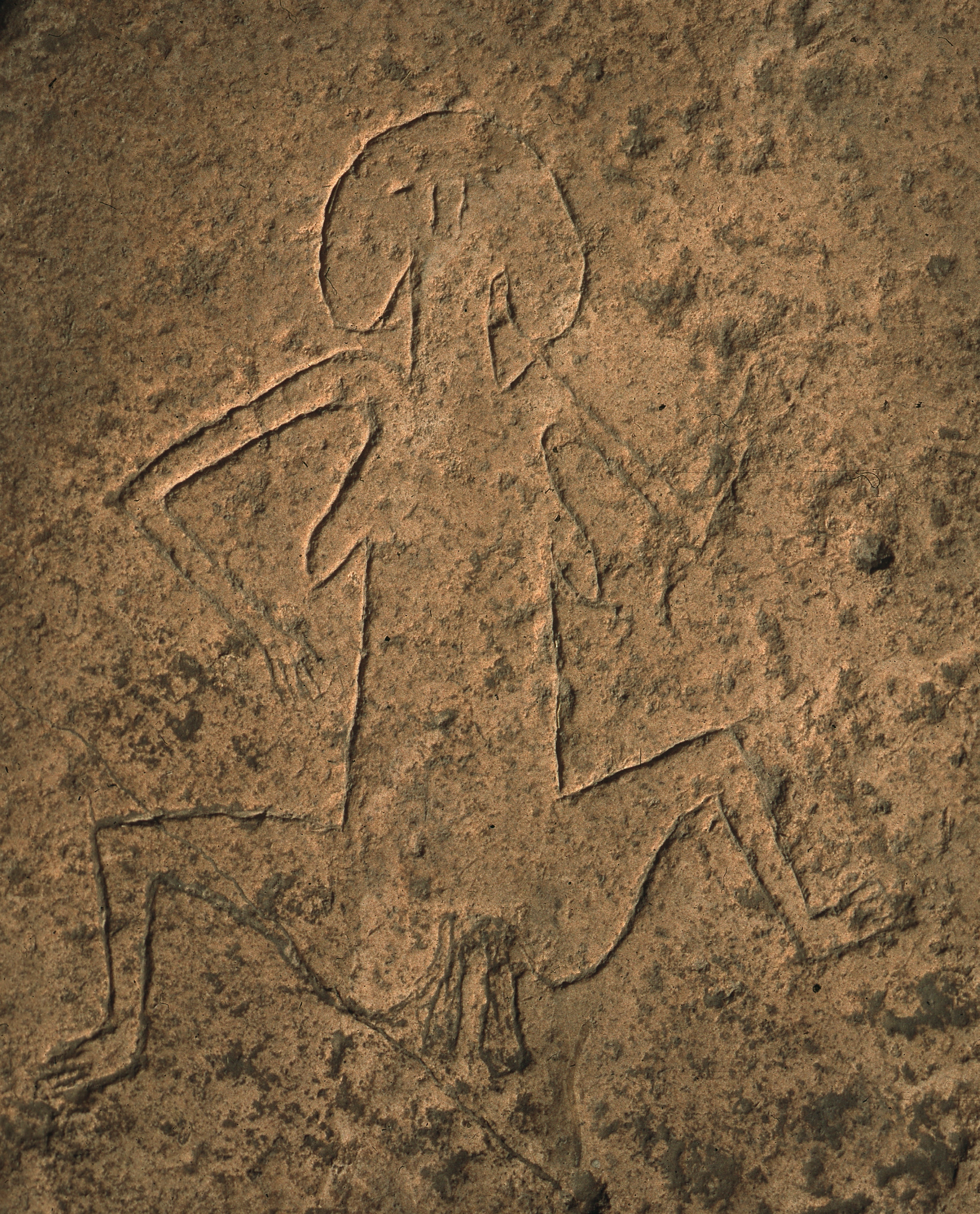
(Photo: DAI, K. Schmidt)
Currently, what are the primary research questions you’re seeking answers to? What themes/questions have priority for the Göbekli Tepe team?
The future still holds a lot of work for ongoing excavation and research. We are in the lucky position now to have gathered a substantial amount of material to be examined and analysed. While in particular conservation issues are an important factor of the research project’s coming task (ensuring proper protection and preservation of the excavated structures), we are also looking forward to finally clarfiy the site’s complex stratigraphy and internal chronology which still is one of the major research questions. Furthermore we aim to expand knowledge of prehistoric building methods and histories due to renewed detailed building research in the excavated PPN A and B structures at Göbekli Tepe while the important bioarchaeological work looking into the complex history of animal husbandry, as well as analysing finds of human bone material will of course be continued.
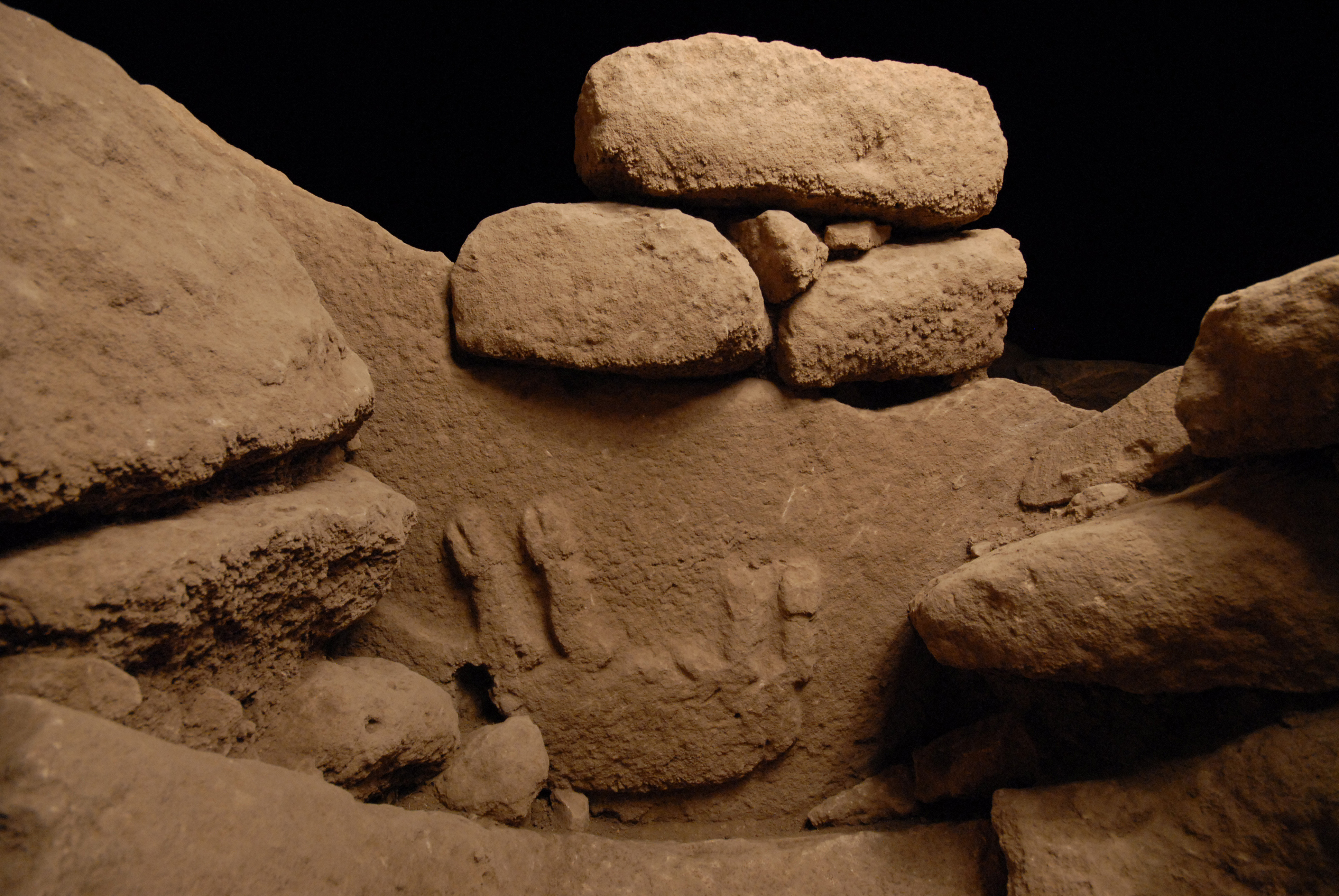
(Photo: DAI, D. Johannes)
How does the work here continue after Klaus Schmidt?
Upon the death of Klaus Schmidt, responsibility for the German Research Foundation-funded project “The early Neolithic society of Upper Mesopotamia and its subsistence” passed to Prof. Dr. Ricardo Eichmann of the DAI, Orient Department for which Dr. Lee Clare coordinates the work of its research staff. Heritage issues at Göbekli Tepe are coordinated by Prof. Dr. Felix Pirson from DAI’s Istanbul branch.
Close cooperation has also been established with the Şanlıurfa Museum, whose director acted as site director (Kazi Başkanı) at Göbekli Tepe since September 2014.
In other areas, the Turkish authorities established a ‘Scientific Advisory Board’ to facilitate collaboration between project stakeholders. This board comprises three eminent Turkish archaeologists: Prof. Dr. Mehmet Özdoğan (University of Istanbul), Doç. Dr. Necmi Karul (University of Istanbul) and Prof. Dr. Gülriz Kozbe (Batman University).
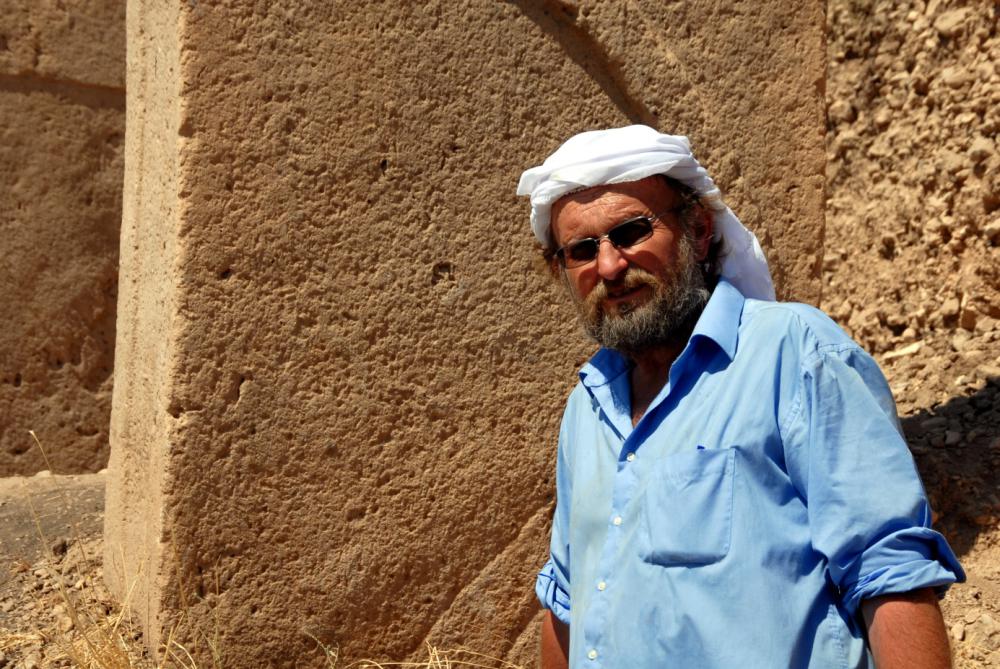
(Photo: DAI, D. Johannes)
What questions/problems/issues do you personally find the most exciting and interesting in Göbekli Tepe? What may the future research shed light on in the upcoming years?
Personally, I am interested in the social implications the findings at Göbekli Tepe put forward: How does the society structure of these hunter groups change once complex communal projects demand cooperation and coordination? When do elites form and rise – and how do they represent themselves?
Furthermore I am also involved in the still challenging task of revising and developing a coherent stratigraphy of Göbekli Tepe’s complex layers and features. This, together with the preparation of a couple of monographs regarding the results of about 20 years of research, it’s finds and findings will be an important task within our research for the coming years.
What do you think may be the pros and cons of the promotion and publicity projects that were recently started at/for Göbekli Tepe?
The public has a justified interest in this kind of research and its results. We are not doing this for our own or to fill up museums and bookshelves, but to actually answer the essential questions probably all of us keep asking: Where are we coming from and how do we get here? Göbekli Tepe certainly is one of those sites considered part of our shared cultural heritage – it is within the realm of interest but also responisbility of each of us. So, of course public campaigns and information projects are definitely considered an important part of our work and indeed supported.
Thank you!
My pleasure, thank you too!
(Original interview published in Turkish at arkeofili.com on September 18 2016; English version by courtesy of arkeofili staff; Turkish translation by Suay Şeyma Erkuşöz, Ayşe Bursalı.)
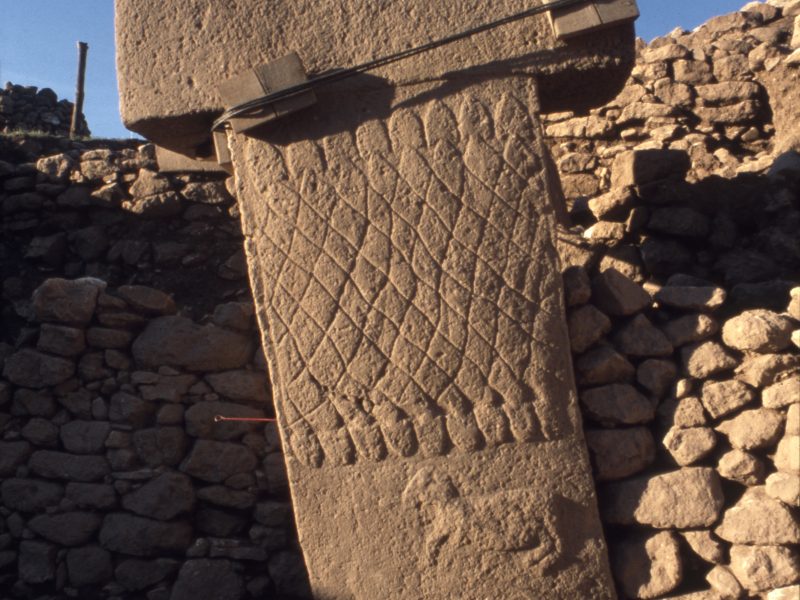
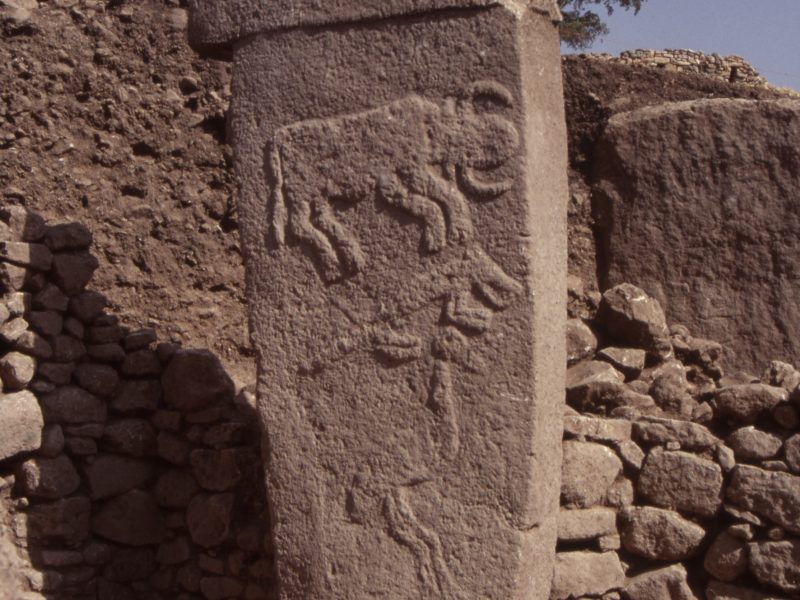
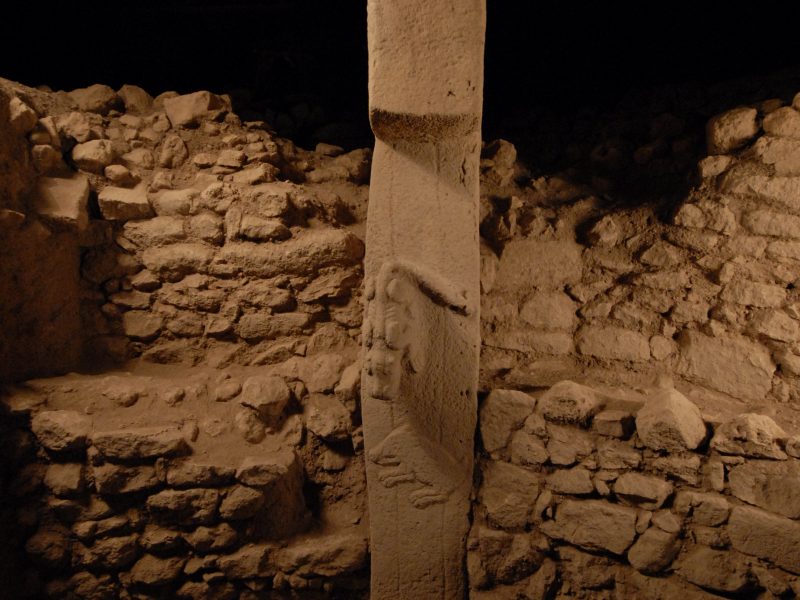
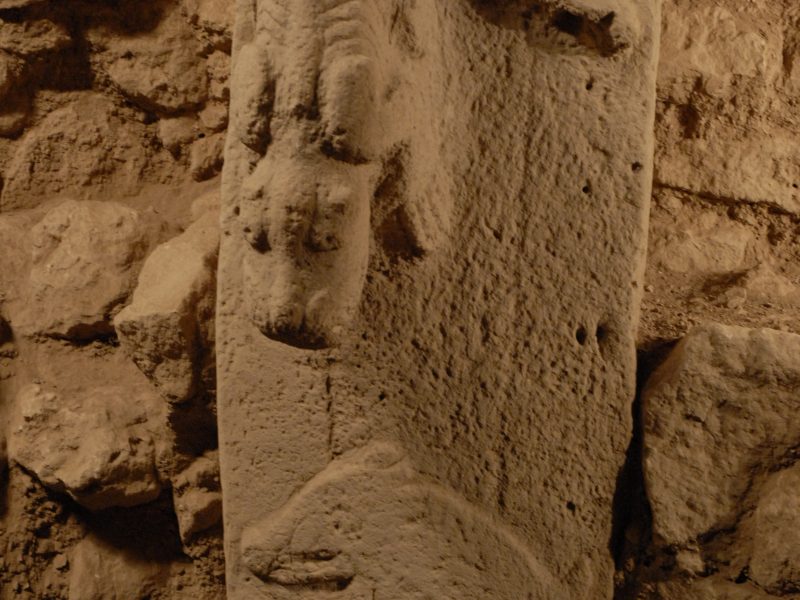
The phrase “while there mostly in settlements only is” does not make sense, and should presumably read “while in most settlements there is only“, or something to that effect.
I asked thus question on fb page too…hoping for an answer! I wish my ignorance to be excused. However, can you tell me why,given it’s the stone age, one of the monoliths has a decorated belt with buckle? Thank you
Thanks for your comment and interest in our research, Lesley. This is a good question, actually.
First of all, we really don’t know if this is meant to depict a ‘belt buckle’ – it’s our own experience and modern conditioning which makes us ‘recognizing’ something he we would find only logical in this context. Second, there are indeed belt fastenings known from this period and region, so called ‘belt hooks’ often made from bone for instance. In this case, however, I personally think this is not a ‘buckle’ but rather the upper part of the fox skin wrapped around the belt.
My alternative theory doesn’t necessarily disprove another alternative theory. As you say in your reply to the question posed by Lesley Donnelly, “it’s our own experience and modern conditioning which makes us ‘recognizing’ something he we would find only logical in this context”. It is also true that science may also be dis-recognizing something that is obvious. Let’s take for instance, the lack of good evidence of suitable tools to cut and shape these megaliths on or near this site. Where are the suitable tools for Gobekli Tepi, Sacshayman, Pyrimids of Giza, Machu Picchu, Pumapunku and Sacsayhuaman among others? Logically, none of these sites could be sculpted by hunter gathers with stone tools or copper tools and who then destroyed them. Yes, one could hypothesize that the hunter/gatherers were more advanced than we “logically assume” according to our modern context but logic should not lead us to assume something which we may have dis-recognized. In this reply I mean to use the words dis-recognize as nominally equivalent to unrecognizable except that unrecognizable is what we see when something has changes whereas dis-recognize is what we assume when we see something for the first time in a different logical context.
The context of the political, social and religious factors surrounding present day excavations at Gobekli Tepi suggests to me that the modern logical context of Eastern Turkey is far different than the modern Western logical context. Therefore, they can and probably will logically assume these excavations have a different interpretation so that the interpretations are not offensive to their secular and religious contexts. However, this gets me to my point, we might assume that Gobekli Tepi is of neolithic human origin but it might be something much more ancient and different if we remove our modern logical context blinders. The lack of suitable tools at the aforementioned sites, I believe, is the crucial missing piece. If the tools are truly missing it simply means these sites were built by someone or something that took the suitable tools with them when they left. If in a million or more years other explorers to Mars find the tiny holes our robots drilled into the rock, at various sites on Mars, will they logically assume they are evidence of alien scientific studies of the evidence of a long lost civilization on Mars? I suppose it depends on their experience and conditioning which enables them to recognize or dis-recognize something they would only find logical in that future context.
Thanks for sharing your thoughts.
It’s interesting that this idea is brought up repeatedly, and I keep wondering where this is coming from. Actually, there are plenty of stone tools at Göbekli Tepe and the Neolithic quarries nearby in particular. The limestone used there is rather soft and easily workable with these stone tools which are really omnipresent at site. We already wrote a piece about this some while ago: //dainstblog.com/2016/05/03/how-did-they-do-it-making-and-moving-monoliths-at-gobekli-tepe
Can you post photos of the tools at GT?
We are currently preparing a study and publication of many of the stone tools present at Göbekli Tepe, but basically any silex or ground stone tool would be suitable to work the rather soft limestone.
Just be sure to state the mol number for the tools and stone work. Thanks
I just read your recent 11/14/16 post on “Dances with Cranes” at Gobekli Tepe. I am responding here because in this article the iconography of the crane in the picture under “What has GT changed about our knowledge of history” shows a crane sitting down with outstretched legs. This is how humans can sit, but in my own non-professional opinion, it doesn’t seem to me that birds can sit this way. I have observed birds sitting with their legs tucked under their bodies, but not fully outstretched in front of them. Moreover, this “bird” seems to be examining an orb suspended over its wing. What is this orb? Is it the sun or the moon? I have always believed that GT was an astronomical observatory of sorts—designed to facilitate the tracking of celestial bodies’ movements. That no evidence exists of astronomical alignment is not evidence that GT was not an astronomical observatory.
Thanks for remark and interesting thought about this vulture depictionon Pillar 43. Interpreting this unusual leg position as another hint at a masked human would be indeed fascinating and probably possible (while another reason could be the space left on the pillar – the legs are unfortuntaley interferring with the pillar head’s border here, so maybe the artist had to deal with external, formal, circumstances as well). We always wondered what this orb in front of the bird could have been – an egg, a head (the one of the headless man below?), or indeed the sun. Plenty of room for interpretation.
Anyway, I never excluded a possible astronomical relation, but since we’re lacking proper evidence and considering subterranean and probably roofed structures here, this would not exactly be my most favourite interpretation. Not saying “No”, but think other interpretations more likely as of yet.
There isn’t any evidence that the structures were probably roofed. The only advantage a roof would have for the walls is to diminish damage to the walls caused by rain, but if the people worked to keep the walls mortared and structurally sound, a roof would have been unnecessary. That the structures were located on top of a high hill would have increased the likelihood of lightning strikes to it, and thus would have served as a very poor location for a roof-covered structure. Perhaps GT’s location was to induce lightning strikes to the pillars. The ancients may have believed that they could cause rain this way, and thus help ensure the success of crops.
You’re right, there is admittedly no evidence of roofs either. Enclosure walls, however, speak arguably in favour for subterranean structures. We’re still looking into this, actually. Believe in causing rain might be an option, of course, yet interest in field irrigation might not have been a top priority here, since the people building these enclosures still were following hunting subsistence according our findings at the site (not a single hint at domesticated plants or animals yet). Also, there’s no sign of lightnings having hit the pillars … I assume that would have left a trace somehow.
I think I remember reading evidence of a destroyed pillar , but will have to re-read the articles I have to locate where I read that info. Can we be sure how “subterranean” the enclosures were, given that the people filled in the enclosures with dirt and artificially created a yet-higher hill? If the walls and pillars were above the ground, they would have attracted lightning. Though no evidence of plant agriculture exists at GT, and other nearby sites there is evidence of plant agriculture. Even if the people at GT only gathered flora, the weather (rain, in particular) still would have been a concern to them.
There are a few destrcutions to some of the pillars, but those are evidently caused by human activity (dug up and smashed, as well as recent farming activitiy and freezing damage).
The outer faces of the walls, which are unlike the inner parts not plastered but ‘leaning’ against the filling strongly suggest (at least partly) subterranean constructions in my opinion.
Lightning strikes would do extensive damage to pillars and buildings. Absolutely no evidence for that, and most pillars do not tower high above the enclosure walls.
Long legged birds such as Cranes, Herons,and Storks, have been photographed sitting in this somewhat human like position.
The emphasis here rather focusses on the apparently ‘wrong’ depiction of bird anatomy – whether intended or not.
In depicted sign language the posture or Stance of Sitting indicates, “remaining” or “waiting” for an “event. In the case of a Bird it indicates, “awaiting-flight.” An America Indian Chief drew his name as a pictograph and depicted A Buffalo Bull sitting in a rather ungainly posture for a bull.
https://www.academia.edu/24674562/Chief_Sitting_Bull_His_Pictographic_Name
One can find another image of a Sitting Bull in the Lascaux Cave in France. The depiction is estimated to be around 20,000 years old. In both cases the Imagery is cosmological. Some tunnel like caves were conceptualized as the “Throat of the earth.” a “connecting tunnel” between between the Stomach or Bowels of the earth and the Mouth viewed as a “water-source.” any subterranean “underworld” source of water such as a spring or seepage from layers of rock on a cliff. Even today we still speak of the Mouth of a Cave or the Mouth of a River. What the chieftains were waiting for within the interior of the Female-earth was their rebirth or resurrection.
The Horned Bull was a representation for a powerful leader or chieftain based on observation of male animals battling for supremacy over the herd.
The central pillars of enclosures c and h were destroyed in prehistory. Pits were dug into the enclosure fillings and the pillars smashed into pieces. There is pottery in these pits that is clearly post-Neolithic.
Regarding subterranean buildings, there are good examples of special purpose structures e.g. from Jerf el Ahmar, Mureybet, or Tell Abr.
In an article in Neo-Lithics (2/2008) it is reported that intense heat cracked pillar 35 in enclosure C, but the “iconoclastic event” was post-Neolithic. Yet enclosure C has two levels, level III (PPNA), where pillar 35 is located, and level II (PPNB). I didn’t understand how the “iconoclastic event” could have occurred to Pillar 35 in the post-Neolithic if level III was covered up by the PPNB.
There seems to be a misunderstanding. Enclosure C is definitely part of the Layer III complex. There is no younger Layer II architecture covering the older stratum in that part of the mound. The “iconoclastic event” that Neo-Lithics paper refers to is a clearly visible (later) pit dug into the filling of this enclosure, apparently directed at its central pillars which were smashed and damaged (with the help of fire it seems) in the event. Pottery in this pit points to a post-PPN event.
In Schmidt (2001) (in Paleorient) on pages 50-—51, Schmidt states that enclosure C was covered up by a PPNB layer. If the central area of enclosure C where pillars 35 and 37 are is not covered up by a PPNB layer, then this means that the enclosure C’s PPNB layer is outside the central area. So this means that pillars 35 and 37 receded into an open hole in PPNB times. This “hole with pillars” would have had PPNB symbolic significance, don’t you think? If this “hole” was filled in post-Neolithic times, only to be re-dug up by iconoclasts, I think an article should be written about this. Are you sure that some post-Neolithic pottery didn’t just travel downwards as an intrusion to the PPNA level? Such intrusions happen a lot in archaeology, right?
Again, definitely a misunderstanding. There never were PPN B structures superposing Enclosure C (cf. e.g. Table 2 here: //dainstblog.com/2016/06/22/how-old-ist-it-dating-gobekli-tepe -Layer III in green, Layer II in yellow). It even seems as if this part of these older structures was deliberately spared from any later construction activity (note the PPN B wall running around the whole area).
The circular enclosures were filled during PPN times (the filling material clearly suggests this), only the pit towards the central pillars of Enclosure C (and H too, by the way) was carried out at a later time – the feature is clearly distinguishable from the rest of the filling.
Hi Jens,
Schmidt (2001) clearly stated that the filling of enclosures A,B, and C was PPNB at the latest. He did mention medieval pottery shards from the uppermost levels. I do not believe that the “iconoclastic” event happened in medieval times. How would the iconoclasts know that there were pillars down there?
Well, that was 15 years ago. None of the enclosures was completely excavated back then. Meanwhile we did reach deeper, excavated two enclosures (C and D) to the floor. Naturally, the picture has changed.
The filling material of course must have been added after use-life of these structures came to an end. PPN B *at the latest* – yet, where exactly the material came from still is major part of our research. A lot of these issues have been addressed in our more recent publications, a complete and continuously updated list can be found here: //dainstblog.com/publications
OK. Thanks a lot for all your feedback.
You’re welcome. Let me know if you can’t find one or another of the articles listed.
Enclosure C does not have two levels. All monumental enclosures belong to Layer III (PPNA/possibly reaching EPPNB). In the area of Enclosure C, there is no Layer II (EPPNB-MPPNB) supraposing this stratum. The pit was dug directly in the refilling of Enclosure C in post-Neolithic times, which is clear due to the presence of pottery that post-dates the Pottery Neolithic of the region. There were traces of fire within the pit, which led to the hypothesis that a fire was deliberately set to crack the pillars. These traces can in no way be related to lightning strikes.
A great read like so much coming out of this project Wonderful to know that many involved with the GT site are keeping such an open mind and letting the archaeology speak for itself. I noted with some interest the comment that the site may have been ‘almost cleared’ before it was in-filled as I had previously wondered if that was a possibility. Keep up the terrific work and I look forward to hearing more regarding your great efforts there.. Many thanks.
The finding about the making of beer is interesting. Beer making is also found among the ancient cultures in Peru and in relationship to their ‘temples.” It may be that beer was more related to the cosmology than to becoming intoxicated. It may have been used to point to the existence of spirits in the water mixture similar to the depictions of water-spirits near the cistern at Gobekli.
In Peru the Moche show depictions of the ritual chewing of coca leaves by Sun-priests. The priests used this to demonstrate the release of the spirits from the leaves by mixing with lime. This was compared with the release of the spirits of their deceased from the waters of the underworld.
https://www.academia.edu/8042352/The_Coca_Chewers_Moche_Vessel_Imagery_The_Wonder_of_the_Lunar_Rainbow
From a socio-cultural perspective, there is an obvious anomaly in the Gobekli tepe ruins. Art has always been thought of as a by-product of culture. If you look at the sculptures, motifs used on the monoliths, it is anachronistic to a prepottery neolithic society. Although little is known on the cultural heights PPN societies had reached, current archeological evidence has given us enough to understand that the people of these time lived simple lives centered on survival using very basic tools. Abstract designs like chevrons, semirealistic depiction of animals in low and high relief, stylization of figures, the use of right angles on the stonework, even the use of symbolism, the ‘H’, and this was before the invention of written language. To say that all these are a product of a stone age society, I think, is quiet far fetched. If you think of the necessary cultural maturity, not to mention engineering prowess and social organization, needed to make such decorated stone structures, and move them, and place it in a context of a neolithic people a time even before pottery was invented, the contrast is striking. There is no knowledge or evidence to prove that the structure was built, other than PPN society. But if such a hypothesis is highly improbable, there is then a large probability it might be wrong. The absence of an evidence to prove otherwise, does not necessarily mean that it is non-existent, we might not have found it yet. But I think, Gobekli tepe is in fact, an evidence and proof to itself.
I do not understand why archeologists cannot think out of the box. As men of science they should be able to make a wide range of hypotheses based on available evidences which may or may not fall into the expectations or worldviews of their colleagues, funding institutions, or even the world at large. Discoveries are made by people who are not afraid of rewriting history, if it is a fact.
Thinking out of the box and rewriting history is exactly what has happened here. 20 years ago everybody would have thought that you are right with your assertions about ‘simple’ hunter-gatherers who have no capacity for large-scale building activities, abstract thinking and so on. Göbekli Tepe, and many other sites, have changed that image. You might not be aware of the fact that GT isn’t an ‘anomaly’, it fits in quite well into our new general image of the PPN. Here is a link to a great (open access) paper by Trevor Watkins, in which you can find an overview of our current knowledge: https://doi.org/10.1017/S0003598X00100122
And the dating of GT really is very secure, you can find lots of information on this blog if you are interested.
Science lives and dies on facts, it is not especially scientific to think outside the box. For example, the commonly accepted fact, at that time, was that the age of the universe was much less 60 years ago than it is now simply because now we can see further back in time with mankind’s new tools. That being said I have an open mind about the GT’s inferred evidence that neo-lithic hunter gatherers had the time, motivation and skill to find, shape and place large enscripted monoliths in a defined design for a specific reason. Megaliths are by definition an anomaly when taken in the context of the commonly understood definition of “prehistoric culture”. So either the commonly understood definition of “prehistoric culture” must change or the commonly accepted definition of “anomaly” must change. That being said, the conjecture that the earth was “visited” is not impossible. For example our “present culture” has sent men to explore the moon, a mere 250K miles from earth and simple robots to explore our nearby interstellar space, all of our planets and several comets within the last 60 years. Some cultures in our galaxy could easily be at least 60 years ahead of our present AI Robotic and scientific achievements and could have easily sent their robotic tools to explore, mine or leave simple evidence of their visits on their planets. Other galaxies may have cultures or Artificial Intelligence many millions of years older than ours and it could easily be imagined that they have sent their advanced A.I. robotics to explore their known universe, too. Who knows what has actually happened here on our earth. It is possible that we could have been “visited” but we have no facts too confirm it, yet. In the meanwhile, the inferred evidence must stand as facts.
P Yabao makes an interesting point, with which I can’t quite agree. I can quite accept that humans around 10, 000 BCE would have had sufficiently developed social & technological culture to build Gobekli Tepe. Simple tools in skilled hands are capable of surprising effects even today.
That said, if Gobekli Tepe strikes one as anachronistic in the Neolithic context, one might assume a much earlier date (for at least part of the construction) rather than a later one. Mightn’t it be the case that the organic evidence for the presence of Neolithic humans (feasting, sacrifice, etc, a la the Iliad/Odyssey) is evidence of people who themselves found (rather than built) this site around the end of the last glacial max? Perhaps some more recent parts of the structure were built in imitation of the older parts? In which case, the later ‘imitators’ may have ha no inkling as to the thinking & intentions of the original builders. Sorry to complicate things but it has to be said.
By the way, is it still the case that the oldest structures have not yet been unearthed, as suggested by Klaus Schmidt in a famous interview?
Sorry, I cannot accept alien visitation theories under any circumstances but am open to persuasion on the vague possibility of pre-human hominid culture.
What Klaus meant was a possibility for Epipalaeolithic settlement layers at GT. He thought that the enclosures were possibly built into an older settlement mound. We are looking into this hypothesis right now with a new series of radiocarbon data. Aliens – definitely not.
Thank you Oliver for replying to my post. It would be fascinating to learn just how old the oldest parts of the site might be. Looking at your aerial photographs it really looks very extensive indeed and how fine it would be to see the entire location as it once was.
Yes, absolutely. We have a series of radiocarbon data back from the lab no, publication will come shortly hopefully. We will definitely post something here as soon as the data is published.
Pillar 1 in Enclosure A shows a net-like pattern formed of snakes and a ram
Depicted sign language and its related cosmology was far older than Gobekli Tepe. Because of this, one need not view the culture related to Gobkli as too primitive to hold a complex concept of religion. The Net was used as a cosmological metaphor by a great many ancient cultures throughout the world. The spirits of the deceased were described as Fish, the ones who swim, or the swimmers. The was partly due to the manner in which the ancient classified animals as, walkers, climber, crawlers, swimmers, and fliers. It was also due to the concept that world beneath the earth was composed of water. Thus the spirits of the deceased, upon their death, plunged into the watery underworld and had to “swim” in order to return to the surface of the earth. This watery metaphor also included water-snakes or serpents that represented the streams or currents within the underworld.
The Net and its association with capturing Fish was applied to the concept of death, and the spirits of the deceased described (depicted) as Fish and as “captives.” A couple of examples drawn from the Ancient Egyptians are panels showing an Underwater scene with bound captives kneeling at the bottom while fish swim around them. There are also examples of Mummy Shrouds that are in the form of Nets with Fish heading upwards. That the Shroud in not a normal fishing scene is verified by the depiction of a Large Dung Beetle, with outspread wings, also being caught up in the same Net.
Returning to the Gobekli Pillar 1 Enclosure A, The Form of the scene is a Rectangle that represents, a vertical-place. This place is, positional, within the under-world as represented by the Large Pillar’s “T” shape that is the, historically documented, gesture sign for, below (the surface). The great-below. The Serpents represent the streams or currents of water, crisscrossing, the underworld. The Diamond shaped signs created by this crossing of currents are the signs for, contained-within. The Serpents Heads allude to their Faces and mean, their appearance, as, male, and female-spirits. The male spirits are defined by their shape based on the male glans penis while the female spirits are defined by their shape based on the Triangular Form of the human female genital area. The Curvature of the Serpent’s Bodies are in the Double Lined Form for, unseen, and their head-ings are, descending ad ascending.
Below the above scene is the depiction of a Ram. A Ram like the Bull, signified, by Horns, indicates a leadership role over the herd. The sign of the Horns was used to depict, the one, the chieftain. The Body of the Ram is composed of the Half Circle sign for, the underside or the underworld. The Rear Legs of the Ram mean, the walks or journeys, positional, on the side, (of the underworld). The Leftward Stance of the Legs indicate, departing. The Front Legs have the same meaning but additionally, have the Stance of, climbing. Of course, the spirit-essence or personification of the Mountain Goat or Sheep represents, the one who climbs the mountain.
The Ram’s Head/Face is towards the Left that in gesture signing indicates, the east. The Head/Face is in the Form of, the male-spirit, sign. The Large Circle that alludes to the Eye indicates, the one, his location,positional, at the edge, of, the surface, of, the underworld (the horizon). The, relatively, Large Eye, represents, the Eye of the Sun, a metaphor used by a great many ancient cultures, to indicate, –Venus.
There seem to be other, weak, signs around the Ram that may have been intentionally rubbed out or have weathered away.
I apologize for the length of this comment but one cannot briefly translate the signs in a way that would make any sense. I hope that the combination of archaeological findings and the use of depicted sign language will, at some point, provide us with a clearer view regarding the true nature of Gobekli Tepe.
Oliver – Will your core sample for carbon dating go as low as the apparant first set of ‘T’s, the original GOBEKLI? I’m in my 80’s, so I won’t see many more digs. Chuck
So far the first ‘Ts’ are in layer III. We have some data published for this layer, and a new series is nearly ready for publication. We have also sampled potentially older layers that have produced no pillars so far – we will definitely post something here as soon as the article is out.
THANKS, Oliver!
Many questions, but first, thank you for the updates on this page, and the comments!
1. I had read elsewhere that all the animals depicted at GT are frightening animals, yet I see what appear to be ducks, cranes, boar, and possibly a sheep and a bovine? Your thoughts?
2. On this page there is a photo of a pillar with what seems to be a sheep beside a fence. Might that suggest animal husbandry?
3. Do you have, or expect to have, additional analysis of material residue in the stone vessels?
4. What are the dimensions or approximate volume of the stone vessels?
5. Do you have analysis of the material used for the “plaster” on the interior sides of the pillars? Do all pillars appear to have been plastered?
6. What is the presumed method of transportation of the large stones, and what support is there for that view?
7. Were the stones rough cut at the quarry and finished on site, or were they finished complete before transport?
8. Has any evidence of the use of cordage been found at GT?
Thanks!
MM
Thanks a lot for your comment. Regarding your questions:
1. Unless your afraid of ducks I‘d say there‘s a much larger variety depicted than only frightening animals. But yes, there are quite a lot of species depicted we today would describe as rather unpleasant.
2. There‘s proof of wild sheep among the site‘s animal bones, but not domesticated ones yet.
3. Literally working on that right now.
4. Up to 160 liters. Have a look here: https://www.cambridge.org/core/journals/antiquity/article/role-of-cult-and-feasting-in-the-emergence-of-neolithic-communities-new-evidence-from-gobekli-tepe-southeastern-turkey/A1AA4FB20657599F859860D94CCD090E
5. Not sure I get the question. The pillars usually are not plastered but cut and carved from limestone.
6. Man power, based on historical and ethnographic analogies.
7. The former option, most likely: //dainstblog.com/2016/05/03/how-did-they-do-it-making-and-moving-monoliths-at-gobekli-tepe
8. No, not yet.
Thanks Jens for your quick reply.
Follow-up questions (same numbers)
2. If animal husbandry or at least corralling was recent to the time of GT, how would/could you tell the difference between wild and “domesticated”, i.e, recently captured and corralled? If I fenced deer in my backyard today, and let them graze freely, would not the venison and the bones be the same as wild deer?
4. Thank you for the link.
5. I was asking the question based on a reply you made earlier (11/15/2016) on this page, viz: “The outer faces of the walls, which are unlike the inner parts not plastered but ‘leaning’ against the filling strongly suggest (at least partly) subterranean constructions in my opinion.” It sounds from this as though the inner parts, then, are plastered?
6. What is the largest stone that has been moved? Ten short tons? 10t = 20000 lb; if the average worker can dead lift and move 100 lb, that would be 200 workers, and there is insufficient room around a stone to position that many workers. In the ethnographic study from Indonesia, the moved stones with “sledges” (I assume what I would call a wooden sled), but that would require cordage, would it not – both to build the sled and to enable sufficient workers to apply force to it. Hence my question regarding cordage. Fairly stout cords, too. Although the distances are not great at GT, the terrain is fairly uneven, is it not? So a sled makes sense.
Thanks!
Mark
2. The difference lies in the bones here. Your captured and fenced deer still are ‘wild’ deer and not domesticated just because you trapped them. If you start breeding these over more than a generation, selecting and multiplying certain favourable characteristics, you’ll start a domestication process which in the long run changes the animal genotypic – and more visibly: phenotypic. But this is an incredibly slow process which needs a lot of time to become perceptible. Generations of animals. That’s why the beginnings of this process (i.e. capturing, fencing, feeding etc. pp) is more described as ‘animal management’ before real domestication starts.
4. You’re welcome.
5. The walls were plastered on the inner face, not the pillars. Parts of this mud-plaster are still preserved.
6. Makes sense but is not visible in the archaeological record, neither sleds nor cords. But that does of course not deny their former existence. Pillars are about 4 to 7 m large with a weight of some 10-20 tons. Many different hypotheses floating around regarding possible movement of these (some discussed in our paper “Building Monuments – Creating Communities. Early monumental architecture at Pre-Pottery Neolithic Göbekli Tepe.” In: James Osborne (ed.), Approaching Monumentality in the Archaeological Record. Albany: SUNY Press (2014), 83-105 – or via google books here: https://books.google.de/books?hl=de&lr=&id=nvAQBQAAQBAJ&oi=fnd&pg=PA83&dq=building+monuments+creating+communities&ots=1p-MSYPsc6&sig=By5U7kjJfQLoaeuFmNpPYxaEFLE#v=onepage&q=building%20monuments%20creating%20communities&f=false).
Re: the definition of “domestication”. In the case of goats, for example, the genotype would have changed (e.g. morphological changes in the horn; males’ smaller size) not because humans purposely selected these changes to occur, but because by breeding only captive animals, traits less adaptive for the wild (horns not viable for ensuring male dominance in the breeding hierarchy; small size more vulnerable to predators) have a greater chance to be passed down to progeny. So if we agree that there were domesticated goats of the 8th millennium BC (by evident horn changes and males’ smaller size), why can’t we say we now have domesticated tigers residing in zoos?
It’s a bit more complicated, and I have to state I’m neither a biologist or zoologist. But to my (limited) understanding, there is a significant difference here to be stressed between ‘managed’ wild animals in captivity, ‘tamed’ animals (like in zoos), and real ‘domestication’. The latter one being a process taking generations of intentional selection and breeding, aimed to secure the predominance of certain wanted characteristics – a permanent genetic modification. ‘Taming’ on the other hand usually describes more the modification of animal behaviour, thus a process of conditioning.
The problem why so many scientific articles have argued about the meaning of “to domesticate” is that this word was not invented not by scientists, but evolved naturally. It is from the Latin, domus, for “house” and was in use in English way before Darwin. Scientists should do away with the term “domesticate” altogether and create new categories, such as you suggested—though do away with the term “wild”, too— and terms to refer to them .
Don’t know. Since ‘domesticated’ animals basically could be subsumed as ‘house’ animals, i.e. in a domestic context, the term does not seem so far off to me …
The term “domesticate” is off because morphological changes from the selective breeding of caprines takes scores of generations to occur, but behavioral changes occur almost immediately. Take a wild goat from it mother before it opens its eyes and it is house-ready.
Well, would fulfill defined requirements for ‘taming’ then – behavioral rather than genetic modification.
To your response regarding “animal management” versus “domestication”: I appreciate the distinction, and am fine with the terms, and would think that animal management would precede domestication and selective breeding. The lack of bones showing changes in phenotypes is interesting. So, when I see the image on the one pillar on this page, which appears (to me) like a sheep or caprine in front of what seems to be a wall or fence, I wounder if animal management might have been practiced around the area of GT at the time of its construction. Of course, shapes that are not obviously certain animal types are subject to various interpretations.
Since ‘management’ would be not visible in the bone material that certainly is a possibilty. But one we hardly can prove or disprove from an archaeological point of view. However, the majority of animal bones found at the site comes from typical wild hunted game like gazelle and aurochs.
Jens
01/22/2018 at 12:11
“The emphasis here rather focusses on the apparently ‘wrong’ depiction of bird anatomy – whether intended or not.”
I don’t understand your response, could you clarify it?
Also, 1. I read somewhere that there appeared to be some channelling of water at Gobekli Tepe but haven’t heard any more about this.
2. Also sometimes the cisterns are in the plural, are there more than one. Are the cistern(s) natural or man made?
The response was aimed on your comment on the cranes. The discussion started here apparently relates to an earlier contribution here: //dainstblog.com/2016/11/14/dances-with-cranes-animal-masquerade-in-pre-pottery-neolithic-ritual
Regarding cisterns (there are a few smaller ones, maybe of natural origin but artifically enlarged, along the plateaus surrounding Göbekli Tepe, but their exact chronological situation remains subject to ongoing study) and water management please see Herrmann & Schmidt (2012): Göbekli Tepe – Untersuchungen zur Gewinnung und Nutzung von Wasser im Bereich des steinzeitlichen Bergheiligtums, in: Klimschaet al. (eds.), Wasserwirtschaftliche Innovationen im archäologischen Kontext, 57-67.
Thank you all for the very interesting discussion. GT is one of the most interesting sites I have ever read about. I look forward to seeing more research from this incredible site.